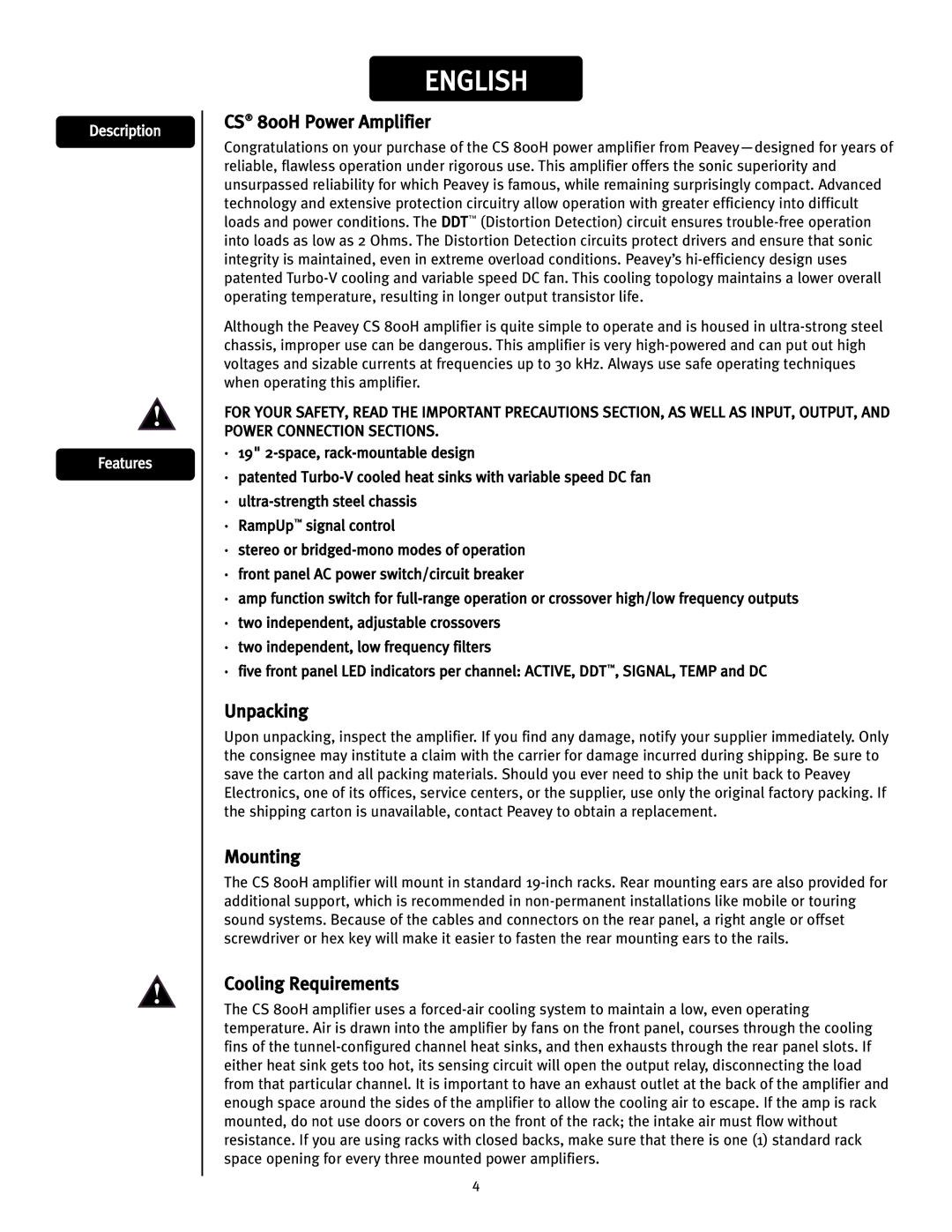ENGLISH
CS® 800H Power Amplifier
Congratulations on your purchase of the CS 800H power amplifier from Peavey—designed for years of reliable, flawless operation under rigorous use. This amplifier offers the sonic superiority and unsurpassed reliability for which Peavey is famous, while remaining surprisingly compact. Advanced technology and extensive protection circuitry allow operation with greater efficiency into difficult loads and power conditions. The DDT™ (Distortion Detection) circuit ensures trouble-free operation into loads as low as 2 Ohms. The Distortion Detection circuits protect drivers and ensure that sonic integrity is maintained, even in extreme overload conditions. Peavey’s hi-efficiency design uses patented Turbo-V cooling and variable speed DC fan. This cooling topology maintains a lower overall operating temperature, resulting in longer output transistor life.
Although the Peavey CS 800H amplifier is quite simple to operate and is housed in ultra-strong steel chassis, improper use can be dangerous. This amplifier is very high-powered and can put out high voltages and sizable currents at frequencies up to 30 kHz. Always use safe operating techniques when operating this amplifier.
FOR YOUR SAFETY, READ THE IMPORTANT PRECAUTIONS SECTION, AS WELL AS INPUT, OUTPUT, AND POWER CONNECTION SECTIONS.
·19" 2-space‚ rack-mountable design
·patented Turbo-V cooled heat sinks with variable speed DC fan
·ultra-strength steel chassis
·RampUp™ signal control
·stereo or bridged-mono modes of operation
·front panel AC power switch/circuit breaker
·amp function switch for full-range operation or crossover high/low frequency outputs
·two independent‚ adjustable crossovers
·two independent‚ low frequency filters
·five front panel LED indicators per channel: ACTIVE, DDT™, SIGNAL‚ TEMP and DC
Unpacking
Upon unpacking, inspect the amplifier. If you find any damage, notify your supplier immediately. Only the consignee may institute a claim with the carrier for damage incurred during shipping. Be sure to save the carton and all packing materials. Should you ever need to ship the unit back to Peavey Electronics, one of its offices, service centers, or the supplier, use only the original factory packing. If the shipping carton is unavailable, contact Peavey to obtain a replacement.
Mounting
The CS 800H amplifier will mount in standard 19-inch racks. Rear mounting ears are also provided for additional support, which is recommended in non-permanent installations like mobile or touring sound systems. Because of the cables and connectors on the rear panel, a right angle or offset screwdriver or hex key will make it easier to fasten the rear mounting ears to the rails.
Cooling Requirements
The CS 800H amplifier uses a forced-air cooling system to maintain a low, even operating temperature. Air is drawn into the amplifier by fans on the front panel, courses through the cooling fins of the tunnel-configured channel heat sinks, and then exhausts through the rear panel slots. If either heat sink gets too hot, its sensing circuit will open the output relay, disconnecting the load from that particular channel. It is important to have an exhaust outlet at the back of the amplifier and enough space around the sides of the amplifier to allow the cooling air to escape. If the amp is rack mounted, do not use doors or covers on the front of the rack; the intake air must flow without resistance. If you are using racks with closed backs, make sure that there is one (1) standard rack space opening for every three mounted power amplifiers.

